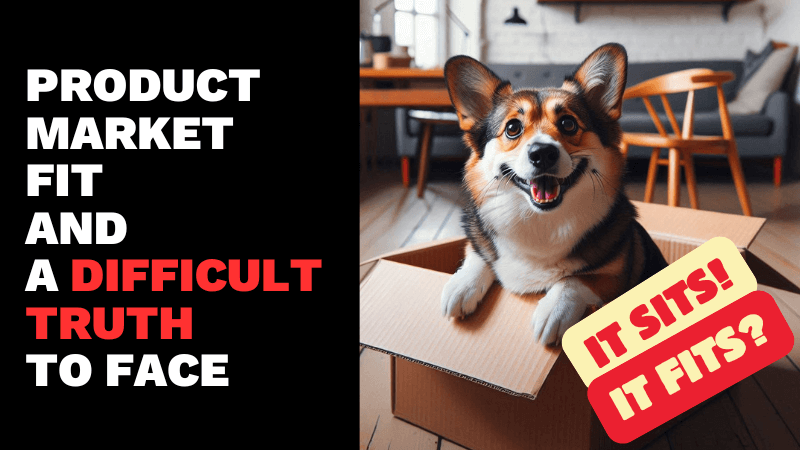Nobody wants to build a product that doesn’t get used. Yet, every day, products are launched to markets that don’t need, want, or buy them. The result? Wasted money, lost time, and, perhaps the hardest pill to swallow, broken pride. The answer to avoiding this painstaking position is achieving the holy grail of entrepreneurship: Product-Market Fit (PMF). I won’t define PMF in this article; let’s ask ChatGPT to do that 👇. Instead, I’ll share my three-step approach to achieving it and product builders’ fatal mistakes on their way there.
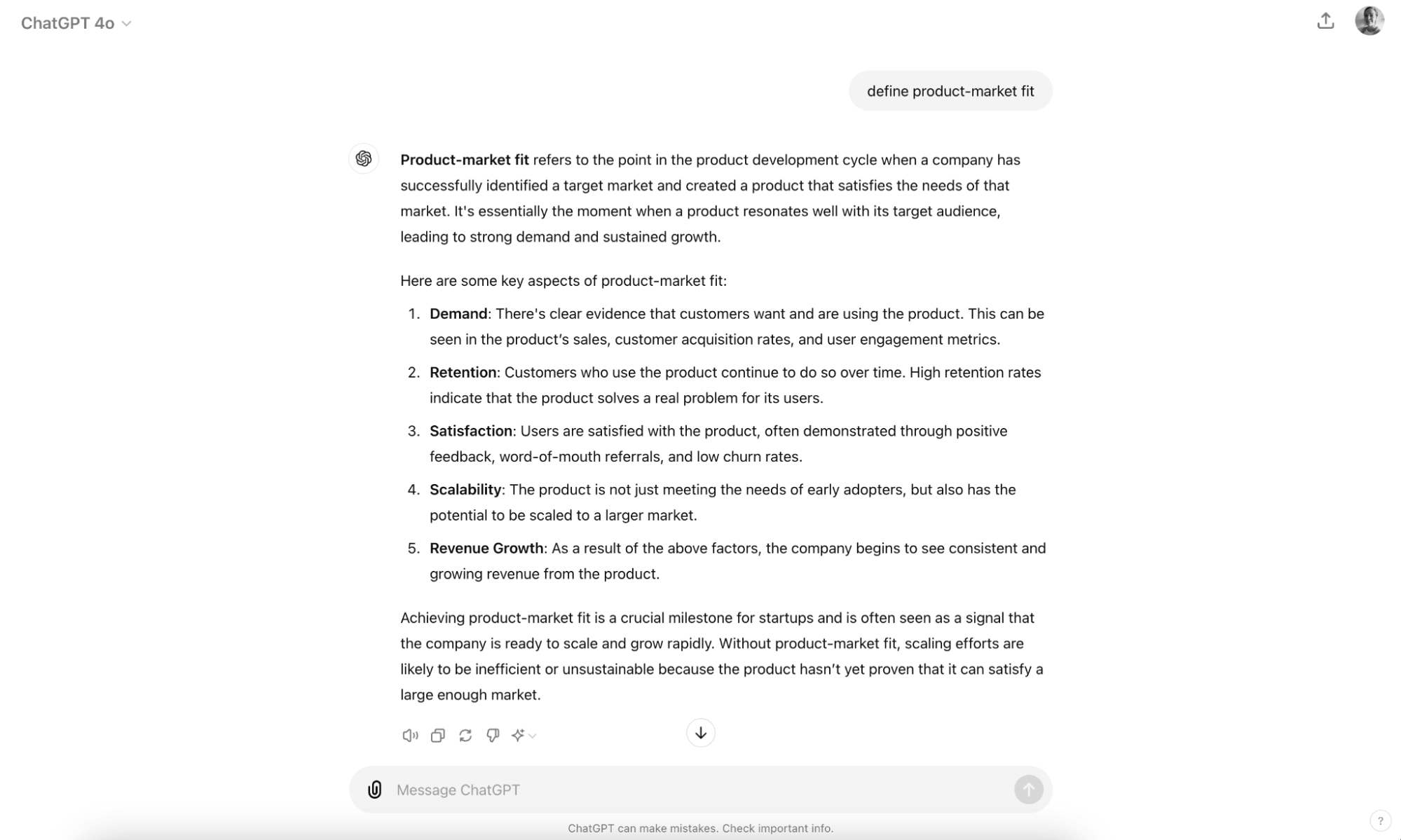
For the past decade, I’ve conducted early-stage, decision-driving customer research for established incumbents like JPMorgan Chase and rising norm-breakers like Astor Finance. My work has helped companies uncover and assess opportunities, define target audiences, and create solutions that deeply resonate with their customers.
I’m also Head of Product at Reeplayer, a seed-stage sports technology startup specializing in video and AI. This dual perspective as a researcher and product builder has given me unique insights into what it takes to create products that truly fit their markets.
I’ve boiled it down into three steps:
- ✅ Committing to a community
- ✅ Building with customers
- ✅ Doing what’s difficult
Using my approach, you can finally stop:
- ❌ Chasing your ideal buyer
- ❌ Guessing what to do and how
- ❌ Competing without differentiation
Committing to a Community
Most product builders are more attached to their product than the people it’s meant to serve. It’s understandable—it’s easy to get excited about your own idea and much harder to sacrifice that vision to serve the needs of others. But without a committed audience, even the most innovative products struggle to find their footing.
Here’s the typical cycle:
- You build something you believe others will buy.
- You launch and go after your target audience.
- The product is not resonating, at least not to the level expected.
- You think it’s an audience issue and pivot your target.
- You pivot perpetually without ever fully committing to an audience.
The cycle repeats until you hit a jackpot or, more likely, run out of cash and/or patience. It’s a tale as old as Silicon Valley and arguably the main reason 90% of startups fail. The 10% who succeed typically realize it’s easier to build a product for a market than to find a market for a product.
Defining Your Market
Defining your market through a community-driven approach provides two crucial advantages over traditional strategies:
- The community-driven approach hits differently. A product built to support a community establishes a strong emotional connection. This bond creates an intangible gravitational pull that is difficult to replicate through other methods. When done effectively, you’ll hear customer feedback such as, “I don’t know, I’d rather go with you guys,” and, “I’m just happy to be part of it!”
- Communities are motivated to support and protect one another. Members share insights, recommend solutions, and actively work to ensure the success of the entire group. If you become part of the community, the inclination to support and protect extends to you. The community becomes your best distribution channel, with members voluntarily acting as your best marketing, sales, and design partners.
The community-driven approach has led to remarkable success for companies such as Patreon, with its independent creators and fans; GitHub, with its open-source developers; Yelp, with its local consumers and small business advocates; and Basecamp, with its entrepreneurial underdogs.
Let’s take a closer look at Basecamp. They started as a web design company but struggled to manage their projects using existing tools. To solve this problem, they built an internal project management tool that eventually became Basecamp. Recognizing that others faced similar challenges, they offered the product to the public. By devoting themselves to solving problems for underdogs—small businesses, startups, and remote teams often overlooked by larger software companies—Basecamp grew into a successful company that has remained profitable and independent with millions of users worldwide.
The table below compares Basecamp’s community-driven approach with traditional market segmentation methods. Do you sense the difference?
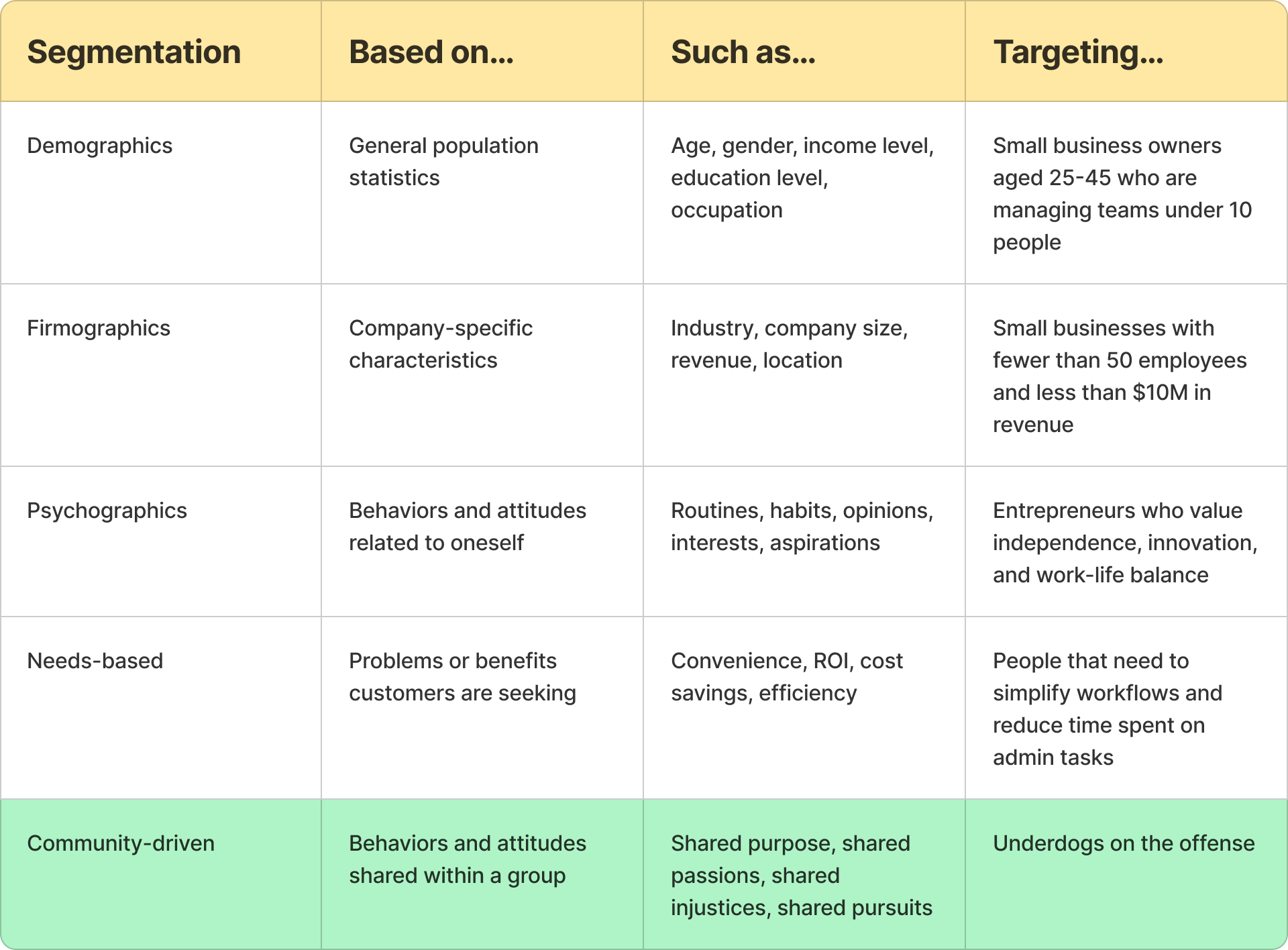
Finding Your Community
There are two main approaches to community-driven segmentation based on whether or not you already have a product: bottom-up or top-down. Here’s how each approach works:
If you already have a product, use the bottom-up approach:
- ✅ Identify who actively uses the product and how they engage with it. Pay special attention to your most engaged users and their frequently used features. These may not be your paying customers or premium features yet, but they signal an underlying demand.
- ✅ Conduct customer research with your most engaged users to understand why they use your product and the context in which they use it. Expand your research by talking to others who might share similar circumstances.
- ✅ Tease out what links them together and define your target community based on their shared attributes. Pivot your product to solve their higher-value needs.
Twitch exemplifies the bottom-up strategy. They initially launched as a general live-streaming platform but struggled to gain traction. Nearing failure, the founders identified a vibrant gaming community within their user base and pivoted to serve this niche. Needless to say, things took off.
If you don’t have a product, the top-down approach is preferable:
- ✅ Ask yourself, “Who do I genuinely want to help?” and define your target community based on the answer. This may seem non-scientific, but it’s a power move. Creating something valuable requires immense dedication and effort. You’re unlikely to persevere unless you’re genuinely committed to serving your chosen community.
- ✅ Start small, regardless of your long-term aspirations. This allows you to build strong differentiators for a targeted group before evolving your niche and expanding your reach.
- ✅ Resist the urge to put the cart before the horse. Immerse yourself in your community’s lives and challenges first, then identify high-value problems and co-develop your solutions.
The founder of Glossier went top-down. Glossier emerged from a community of beauty enthusiasts built around the blog “Into the Gloss.” The founder—a beauty enthusiast herself—used her intimate understanding of the community to hit home runs with product after product. Allegedly, Glossier eventually lost its community focus, and its popularity dwindled.
The takeaway? Commit and stay committed.
Building With Customers
Building with customers isn’t about asking for their feedback on your ideas. It’s about understanding where they are and where they want to be and connecting those dots by integrating their insights with your strategic vision of the problem and the opportunity.
You’ve likely heard the standard advice:
- Do continuous discovery.
- Listen to customer feedback.
- Involve customers early and often.
- Get something out there and iterate fast.
However, many product builders make the mistake of starting with a narrow focus on solutions. Your initial research should be broader, concentrating on understanding the underlying problems and exploring various possibilities. Immerse yourself in the lives of your community, whether online or in person, to truly see their experience from their perspective. One effective method for achieving this is journey mapping.
Here’s how you can do it:
- Outline the overall journey your potential product might support. Zoom out enough to gauge potential solutions’ relative importance compared to the big picture. For example, if you’re in the home security space and have committed to a community of people who seek peace of mind when they are away, your journey might look something like this:

Notice how the journey has nothing to do with home security.
- Ask your community to describe how they currently navigate the journey. Don’t mention your potential solution; let them talk about the aspects that are important to them. Adjust your journey steps if needed. Depending on your situation, you may have to cover variations of your core journey, such as short vs. long periods away from home.
- Document the activities, tools, problems, and workarounds the community members use to complete the journey or achieve the desired outcome. Collect detailed insights into the reasons behind people’s actions and their emotional responses.
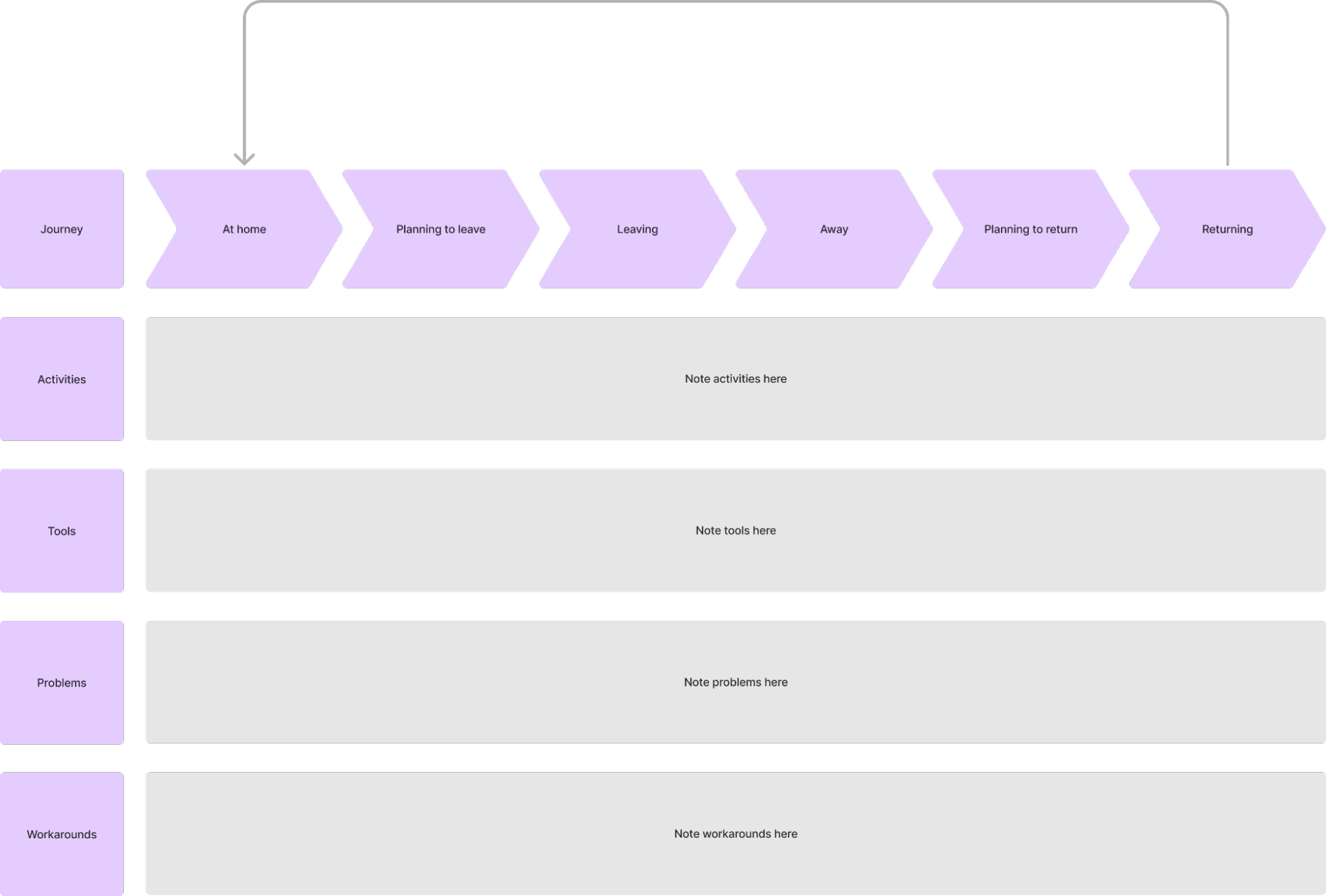
You can have your community complete the journey or do it on their behalf.
- Ask community members to rate their level of satisfaction at each step of the journey. Have them draw an arch to visualize their current-state experience, noting where they felt positive and encountered difficulties. Follow up to gain deeper insights into the reasons behind these highs and lows.
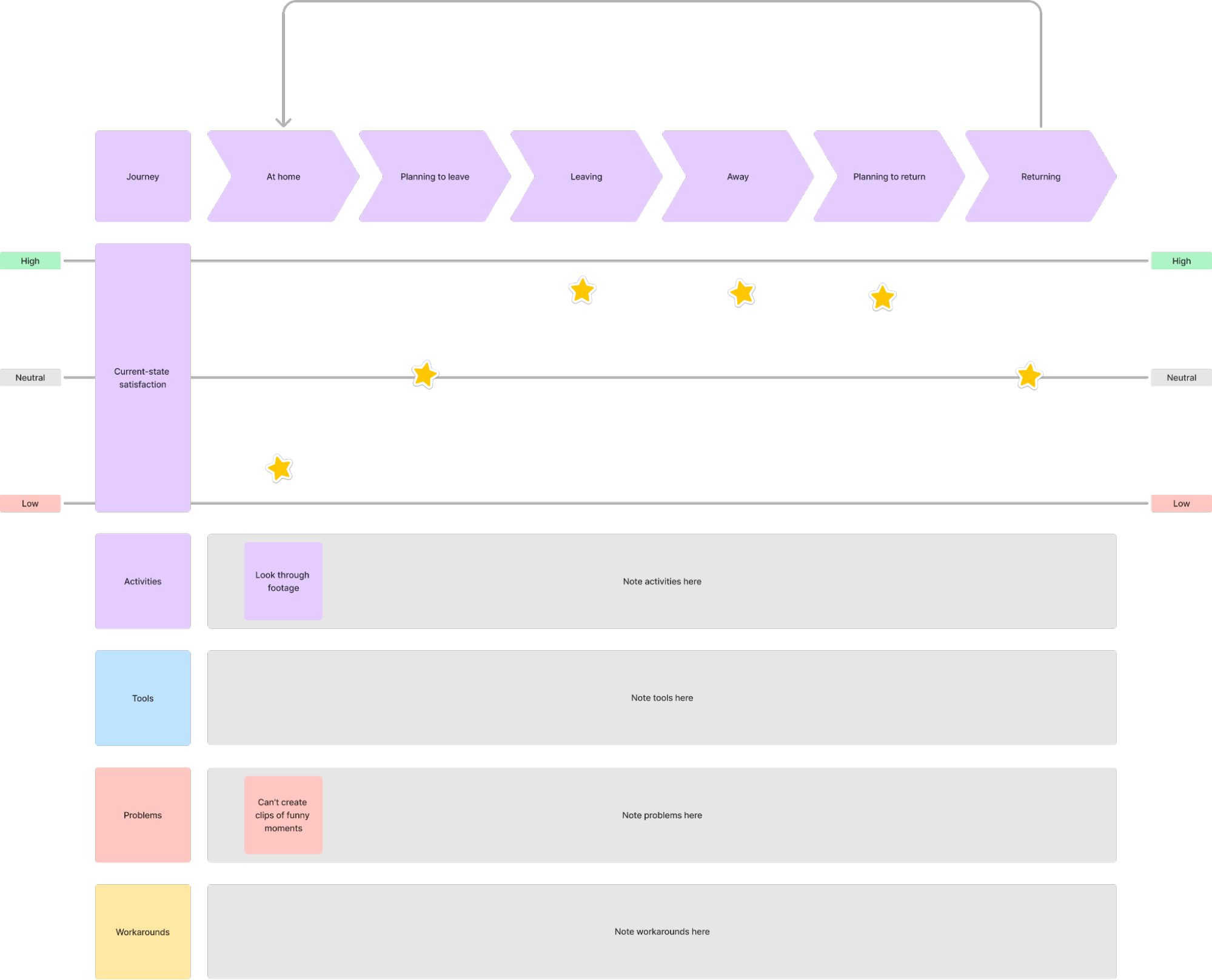
Use the journey map to evaluate whether your current product or early ideas align with the major pain points or dips identified in the journey. If they don’t, you’re likely not addressing a pressing enough issue to capture your community’s attention long-term. In such cases, it’s crucial to pivot toward a higher-value problem.
The following attributes typically characterize high-value problems:
- They are deeply rooted pain points significantly impacting your community’s lives or businesses. Solving these issues can dramatically improve their experience or outcomes, making your solution something they can’t resist.
- If left unaddressed, these problems can have substantial negative consequences for your community. By tackling them, you provide transformative benefits that make your product indispensable to their daily operations or lives.
Doing What’s Difficult
Many companies discover that high-value problems are much harder to tackle than the low-hanging fruit they often gravitate toward. While the easy opportunities might offer quick gains, they have significant downsides.
Low-hanging fruit:
- ❌ Diminish your perceived value: Your community is acutely aware of its real challenges and will quickly recognize when you sidestep them. Addressing their real problems head-on is the fastest way to earn their loyalty.
- ❌ Attract large swarms of competitors: If you can find an easy solution to a simple problem, expect others to do the same. Ironically, distinguishing yourself in a crowded market will be harder than addressing the more difficult issues others avoid.
- ❌ Distract you from long-term goals: Quick wins can divert your focus from strategic, high-impact efforts that drive sustainable growth. Pursuing more challenging problems keeps you focused on building lasting value.
High-value problems don’t always involve cutting-edge technology or groundbreaking innovation. Often, they revolve around integrating, streamlining, and simplifying existing processes, which can be brutally difficult. I know first-hand how agonizingly tough it is to strip away features, reduce complexity, and craft intuitive user experiences, demanding precision, intuition, and deep insight.
It’s also easy to underestimate the challenges that successful companies initially tackle, as their solutions can seem deceptively simple in hindsight. This can mislead those seeking Product-Market Fit into thinking that success comes from easy wins rather than tackling the tough, underlying problems that truly matter. Just think about these examples:
- Zapier tackled the challenge of enabling non-technical users to automate workflows across disparate platforms—a problem that previously required complex, custom-coded solutions.
- Robinhood disrupted the financial industry by eliminating trading fees and simplifying investing, making the traditionally exclusive world of stock trading accessible to everyone.
- Nuro addressed the costly and logistically challenging “last-mile delivery” problem with autonomous vehicles, providing a solution that redefines e-commerce efficiency.
- Square revolutionized payment processing by creating an affordable, easy-to-use POS system, removing barriers that kept small businesses from accepting card payments.
- Canva democratized design by developing a platform with intuitive drag-and-drop functionality and a rich library of templates, allowing non-designers to design.
Each company tackled a difficult problem that others hadn’t solved, leading to the creation or domination of a market. However, achieving Product-Market Fit is just the first step; the market continues to change, and you must evolve with it.
Consider Relay.app. They took what Zapier had developed and expanded upon it. Instead of just automating workflows, Relay introduced AI-driven assistance and human oversight with their “Human-in-the-Loop” feature, allowing teams to automate complex tasks while incorporating crucial human judgment. This innovation didn’t stem from pursuing easy wins but rather from addressing the unmet needs of users who required more than basic automation.
Relay’s success demonstrates the power of continual improvement and deep community involvement. They listened to their users, integrated closely with popular tools like Slack and Notion, and refined their platform to meet evolving needs. This has positioned it as a strong alternative to Zapier and an emerging leader in its own right, establishing a new standard for what workflow automation can accomplish.
Creating something meaningful is challenging, but doing it with a dedicated community makes the journey incredibly rewarding. If you listen attentively, apply yourself wholeheartedly, and remain focused on the outcomes you create for others, your chances of achieving Product-Market Fit are high—it most likely just won’t be with the product you think you’re building.
To see community-centered product development in full-fledged action, follow Amanda and the Reeplayer team on LinkedIn.
Amanda Sanchez is an experienced customer researcher, UX designer, and Head of Product at Reeplayer. Leveraging her expertise, Amanda meticulously crafts experiences that align with untapped customer needs and desires. Her work is marked by an unwavering focus on outcomes and a keen attention to detail, ensuring every interaction drives meaningful impact for the business and its customers.
No Cookie Banners. Resilient against AdBlockers.
Try Wide Angle Analytics!
